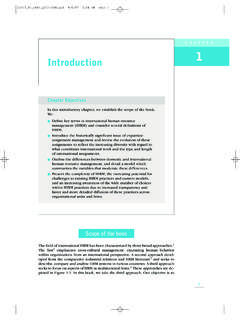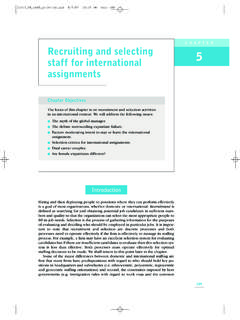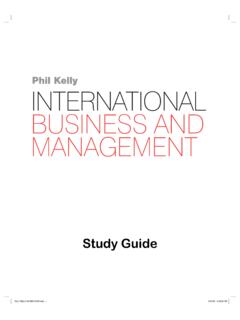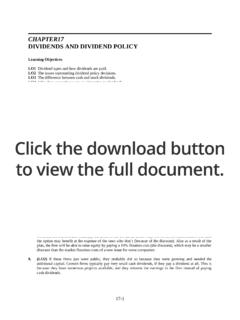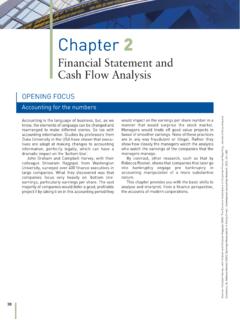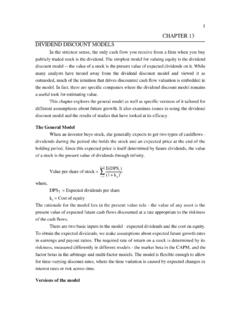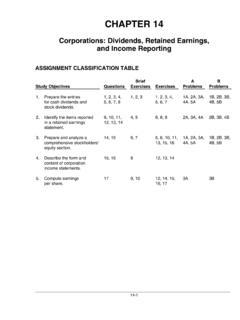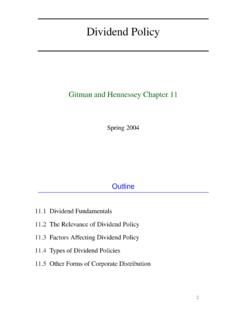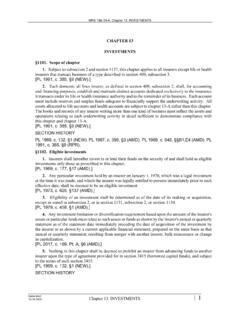Transcription of CHAPTER 13 CONCEPT REVIEW QUESTIONS
1 Introduction to Corporate Finance, Megginson, Smart and Lucey Answers to CONCEPT REVIEW QUESTIONS CHAPTER 13 CONCEPT REVIEW QUESTIONS 1. What policies and payments comprise a firm s dividend policy ? Why is determining dividend policy more difficult today than in decades past? A firm s dividend policy refers to its choice of whether to pay out cash to shareholders, in what fashion, and in what amount. The most obvious and important aspect of this policy is the firm s decision whether to pay a cash dividend , how large the cash dividend should be, and how frequently it should be distributed. In a broader sense, dividend policy also encompasses decisions such as whether to distribute cash to investors via share repurchases or specially designated dividends rather than regular dividends, and whether to rely on stock rather than cash distributions.
2 Non-traditional forms of dividend payments, especially share repurchases are much more commonly used today, and so the dividend decision is much more complex and difficult than in the past. Also, there are many more important categories of shareholders who must be satisfied today especially institutional investors whereas managers once merely had to satisfy individual stockholders. 2. What do you think the typical stock market reaction is to the announcement that a firm will increase its dividend payment? Why? An increase in the dividend payout is considered to be good news. The firm is demonstrating that it not only has positive cash flows, but these cash flows are increasing enough to justify a higher payout to shareholders.
3 The firm proves its cash flow by paying out some of that cash to its shareholders. Higher dividends may signal permanent higher earnings for the firm Introduction to Corporate Finance, Megginson, Smart and Lucey Answers to CONCEPT REVIEW QUESTIONS 3. Why should we expect a firm s stock price to decline by approximately the amount of the dividend payment on the ex- dividend date? The firm has removed an amount of cash equal to the amount of the dividend from the firm. It s total assets have declined, so its market capitalization and, in turn, the stock price should decline by this amount as well. 4. How do average dividend payout ratios for companies headquartered in English common-law countries compare with those of companies headquartered in civil law countries?
4 What explains this difference? With the exception of the companies, firms headquartered in English common law countries (Britain, Canada, Australia, New Zealand, etc) tend to pay out significantly higher fractions of their earnings as dividends than do companies headquartered in civil law countries. The Law and Finance explanation for this is that common law provides much greater protection to small investors than does civil law, and thus shareholders are able to demand higher dividend payments in common law countries. Firms in civil law countries do not face such effective demand from shareholders and are more able to ignore their preferences for higher dividends.
5 5. If high- dividend stocks offer a higher expected (and required) return than low- dividend stocks, due to the higher personal taxes levied on the former, why don t corporations simply reduce dividend payments and thus lower their cost of capital? If the cause and effect were this simple and this was the only factor then firms could reduce dividend payments to lower their cost of capital. In reality, the relationship is more complex. First, using return on equity x retention ratio as an approximation of growth, lower dividend payouts means higher retention and higher growth. A higher growth means a higher, not a lower cost of capital.
6 If firms reduced their dividend they would need positive net present value projects to invest in to satisfy investors. If they took the reduced dividend and invested in Introduction to Corporate Finance, Megginson, Smart and Lucey Answers to CONCEPT REVIEW QUESTIONS treasury securities (negative net present value investment for the corporation), then shareholders would sell their shares and invest in a value-maximizing firm 6. Which industries are characterized by relatively high dividend payout ratios? Are these same industry patterns observed in other industrialized countries? What explains these industry patterns? Utilities, transportation companies, financial institution and companies involved in heavy manufacturing firms tend to have high leverage and high dividend payouts in all countries, while service firms, high-technology companies and firms with highly variable earnings ( , mining) tend to have little or no debt and have low dividend payout ratios.
7 This pattern of dividend payouts is explained by the same factors that influence capital structure decisions: regulated companies and firms with stable cash flows and stable asset bases tend to have high leverage and high payouts. Companies operating in a volatile industry or which must make ongoing and high-risk discretionary investments in new technologies have little or no debt and low dividend payouts. 7. What is the basis of the argument that transactions costs provide a reason for firms to pay dividends, and how has the steep decline in transactions costs in recent years affected this argument? You could look at companies with high payout ratios, and look at how much external financing they raised, along with the flotation costs of that financing.
8 You would look to see if firms with higher dividend payouts had more or less external financing. Was it lower cost debt financing or higher cost equity financing? If a company s transactions costs for external financing were higher than average, did they have a lower than average payout ratio to minimize their need for external financing? Introduction to Corporate Finance, Megginson, Smart and Lucey Answers to CONCEPT REVIEW QUESTIONS 8. What does it mean to say that dividends are irrelevant in a world without taxes or other market frictions? dividend irrelevance means that a firm s decision whether or not to pay a cash dividend cannot impact the value of that firm s stock in a world without market frictions.
9 Investors can create their own dividends (cash income) by selling shares, so they find no benefit in receiving dividends. Likewise the firm can either pay or retain cash, but if it pays dividends out the firm must sell new shares to make up the cash flow difference. Ultimately, the company s stock price will be based on the stream of profits generated by the firm s existing assets and its new investments, not on how it finances itself (through retention or new share issuance). 9. Managers of slow-growing, but profitable, firms ( , tobacco companies) should pay out these high earnings as dividends. What can they choose to do instead?
10 If managers of profitable companies kept their earnings instead of paying them out as dividends, they might invest in negative net present value projects. If they are in a low growth industry, and do not have good uses for their earnings, they might be tempted to increase the size of the company by buying other companies. If there are no particular synergies benefits of the two companies being together rather than operating separately then the acquisition is not value increasing and should not be done. 10. How do Miller and Modigliani (M&M) arrive at their conclusion that dividend policy is irrelevant in a world of frictionless capital markets?



